Choosing the Right Shipping Container
So, you’ve decided to buy a shipping container but aren’t sure where to begin. This guide will walk you through everything you need to consider to choose the perfect shipping container for your needs.
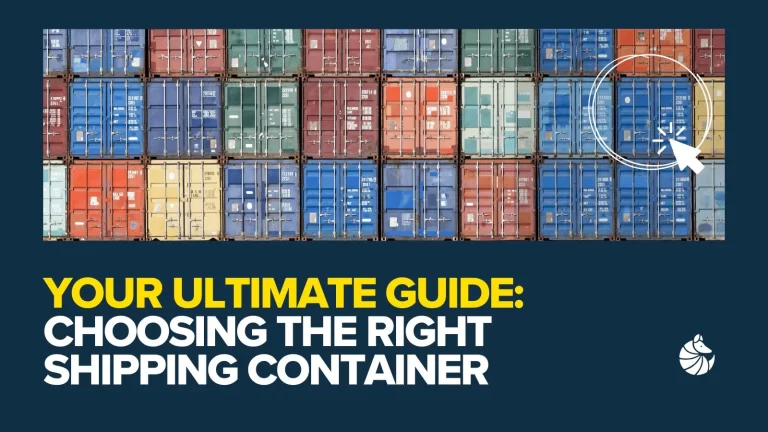
So you’ve decided to purchase a shipping container but need help figuring out where to start. Should you go with a 20ft container, a 40ft container, or a non-standard size?
What about the height of the container?
Should you pick a new unit or stick with a used one?
If this is your first time shopping for a shipping container, navigating all the details and specs can seem overwhelming — but it’s actually pretty simple. Selecting the right container comes down to five key elements: size, spec, type, condition, and budget. This guide covers everything you should consider when choosing the right shipping container.
Before You Get Started
Let’s level-set: What is a shipping container?
Shipping containers, also known as “conex containers”, “cargo containers”, “storage containers” or simply “boxes”, are large steel boxes manufactured and used for international shipping. They carry everything from shoes to food, medicine to toys.
You might be surprised to learn that most of the things surrounding you were transported by shipping containers. In fact, around 90-95% of the world’s goods are transported by shipping container.
And with that, it’s time to dive in!
1. Shipping Container Sizes & Dimensions
When you’re choosing a shipping container, size matters. Understanding the different sizes can help you find the perfect fit for your needs. Here’s a breakdown of the most common shipping container sizes and how they’re typically used.
Standard Shipping Container Sizes
- Dimensions: About 20 feet long, 8 feet wide, and 8.5 feet high.
- Capacity: Around 1,170 cubic feet.
- Uses: Great for small to medium storage needs, shipping goods, and smaller construction projects.
40-Foot Containers
- Dimensions: About 40 feet long, 8 feet wide, and 8.5 feet high.
- Capacity: Around 2,385 cubic feet.
- Uses: Ideal for large storage needs, extensive shipping requirements, and bigger construction projects.
High Cube Shipping Containers
20-Foot High Cube Containers
- Dimensions: About 20 feet long, 8 feet wide, and 9.5 feet high.
- Capacity: Around 1,300 cubic feet.
- Uses: Perfect for storing taller items or when you need extra vertical space.
40-Foot High Cube Containers
- Dimensions: About 40 feet long, 8 feet wide, and 9.5 feet high.
- Capacity: Around 2,700 cubic feet.
- Uses: Great for large items, high-volume storage, or when extra height is useful.
Specialty Shipping Container Sizes
- Dimensions: About 45 feet long, 8 feet wide, and 9.5 feet high.
- Capacity: Around 3,040 cubic feet.
- Uses: Perfect for very large storage needs or extensive shipping purposes.
- Dimensions: About 10 feet long, 8 feet wide, and 8.5 feet high.
- Capacity: Around 560 cubic feet.
- Uses: Best for small storage solutions or limited space applications.
Refrigerated Containers (Reefers)
- Sizes: Commonly in 20-foot and 40-foot lengths.
- Features: Equipped with temperature control systems.
- Uses: Perfect for transporting and storing perishable goods.
How to Choose the Right Shipping Container Size
When picking the right shipping container size, consider the following:
- Purpose: What will you use the container for? Storage, shipping, or a building project?
- Space: How much space do you have for the container?
- Volume: How much storage capacity do you need?
- Budget: Larger containers usually cost more, so keep this in mind.
By understanding the different sizes and their uses, you can find the perfect shipping container for your needs. Whether you’re looking for storage, shipping solutions, or creative projects, there’s a shipping container size that’s just right for you.
2. Container Conditions: New vs. Used
Now that you know what size of container you need and how high it should be, it’s time to decide if you want to purchase a new container or upcycle a used one.
New (One-Trip) Shipping Containers
New containers, also known as one-trip containers, are units that have only been used once to ship a single load of dry cargo on their journey to the U.S. These containers are durable, built to last for 25-30 years, and do not require any upfront maintenance or painting.
While they may have light scratches and dents on their interior and exterior, one-trip containers are the newest and nicest containers available on the market. Additionally, if you purchase your one-trip container from Caleb Wedman Containers, you’ll be covered by a 5-year condition guarantee.
One-trip containers are ideal if:
- Your container will be placed in a highly visible area (e.g., visible to neighbors or customers).
- Your container will be used to build a dwelling, such as a tiny home, office, or cabin.
- Your container will be associated with an upscale, customer-facing business — like a winery or public park.
- You need a container for international shipping.
Here are some new “one-trip” containers we’ve delivered recently.
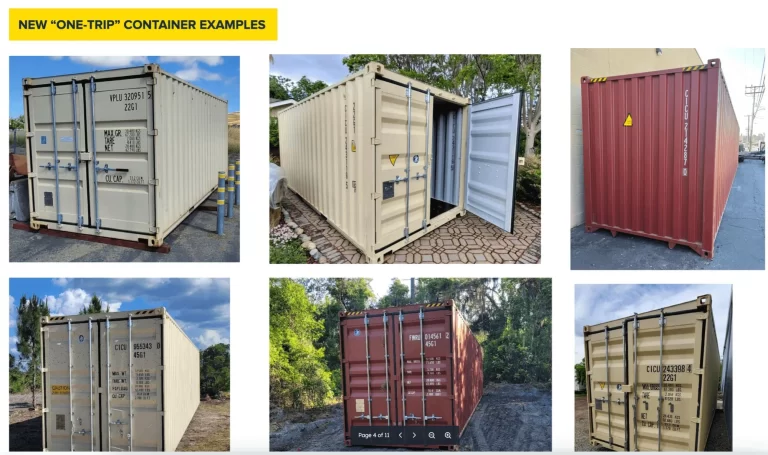
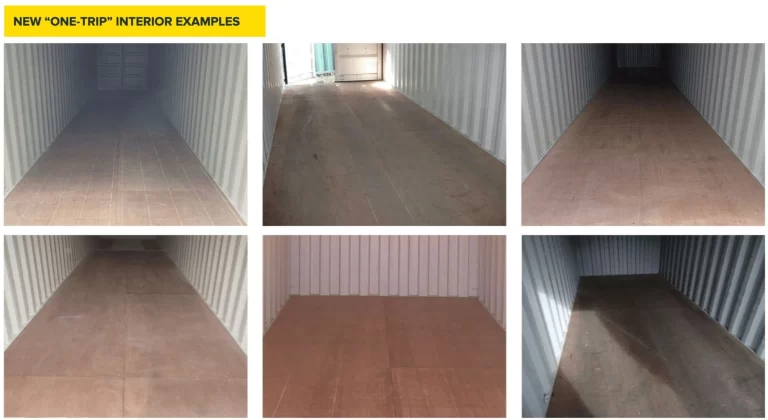
Used Shipping Containers
Used containers, also known as “wind & watertight” containers, have spent an average of 12-18 years at sea (sometimes longer) and will have clear evidence of their many journeys on rough seas (i.e., dings, dents, and surface rust).
Some used containers can still be used for international shipping (known as “cargo-worthy” containers). Others are no longer stackable for shipping purposes, but are guaranteed wind & watertight — that means no holes or leaks.
If you’re buying a used container for international shipping, you will need a used container that lives up to all requirements for international shipping and exports. This includes the ability to pass a CSC inspection, which certifies that a container can safely:
- Carry the cargo weight it’s intended for
- Be stacked and transported onboard container ships.
Certification is an at-cost service that can be coordinated by Calebwedman upon your container purchase.
Additionally, if you’re looking for cost-effective options for storage or if you plan to modify your container for non-dwelling purposes, any used container is suitable. They’ll show significant signs of wear, including dings, dents, and patches of surface rust. But their floors are intact, their doors seal properly, and they’re guaranteed watertight.
Here are some used containers we’ve delivered recently.
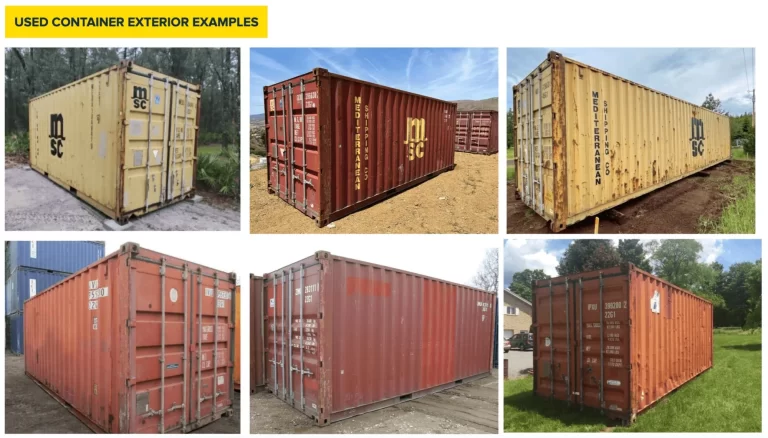
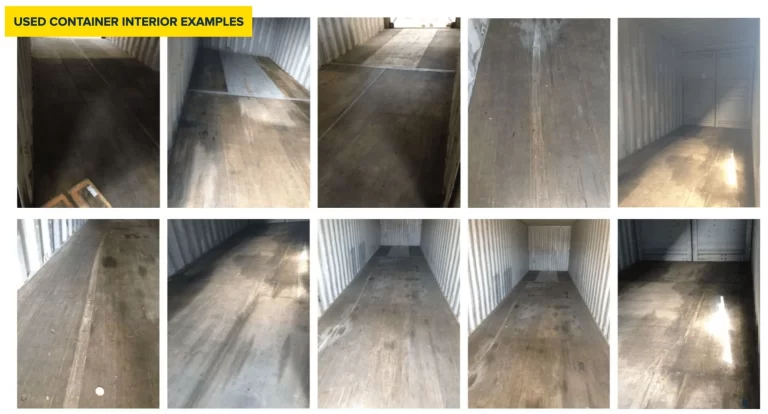
This chart offers an at-a-glance comparison of the different kinds of container conditions and what you’ll get with each.
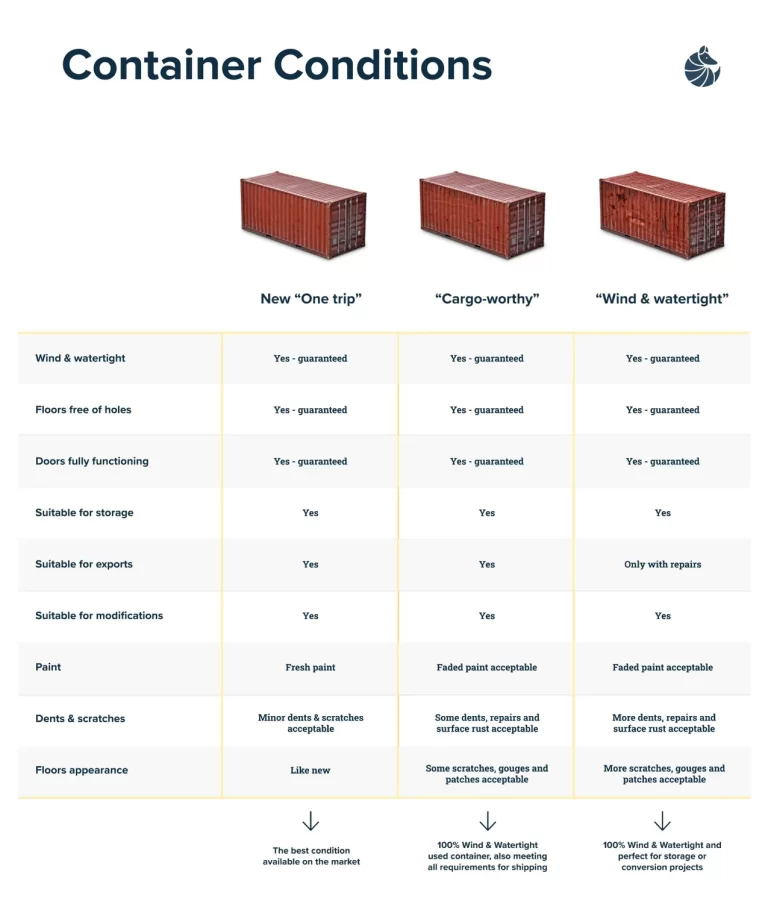
3. Container Types: Standard, Refrigerated & Specialty
After you’ve figured out the dimensions and state of your container it’s crucial to consider which kind of shipping container would be the most suitable, for your requirements.
Standard containers are widely available and uncomplicated to find. They usually have four steel walls, a door. Are ideal, for dry storage and shipping purposes. Any alternative uses like housing, retail, agriculture or others will need some modifications.
Refrigerated (“Reefer”) containers are also an option to explore.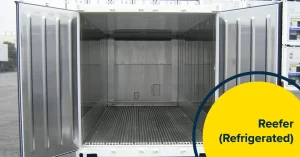
“Reefer” containers have been modified with refrigeration units. During transport, these units connect to the power supply aboard the cargo ship, allowing the container to store goods that require temperature control. These may include fruits and veggies, dairy products, flowers, meat, fish, and even pharmaceuticals.
Specialty Containers
Specialty containers have been modified with unique attributes based on specific use cases and needs, such as double doors, an open top or sides, and more.

Double-door Containers
With entrances on both ends double door containers offer access and can be divided into distinct sections making them ideal for storage or building offices and retail kiosks.
Open Top Containers
These open containers are great, for storing items that require loading, such, as cement or bulky goods as they do not have a roof. Unlike containers top containers lack side doors. Yet you can shield the top with a tarp to safeguard the contents from the elements.
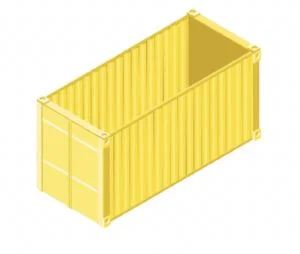
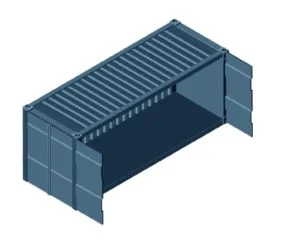
Open Side Containers
They are also referred to as “ventilated containers“. Feature openings, on each of the four sides. These openings allow for air circulation making them ideal for storing perishable items like fruits and vegetables.
A Flat Rack Containers
Flat rack containers are excellent, for moving oversized goods that don’t fit in a container. These containers feature walls or support posts at each end allowing for effortless loading of cargo from, above or the sides.
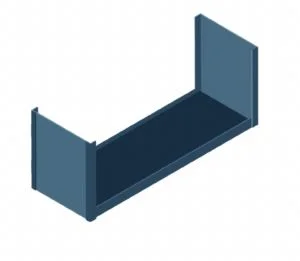
4. Container Specifications
In addition to size, specs also matter. There are two specs you can choose from when purchasing a shipping container — shipping and storage.
Shipping Spec Containers
Shipping spec containers are designed to spend most of their time on the backs of trucks. They’re usually opened and closed while still on the chassis as they get loaded and unloaded at factories and warehouses. Because of this, they have lower handles, also known as “locking gear,” that can be easily operated by people standing on the ground.
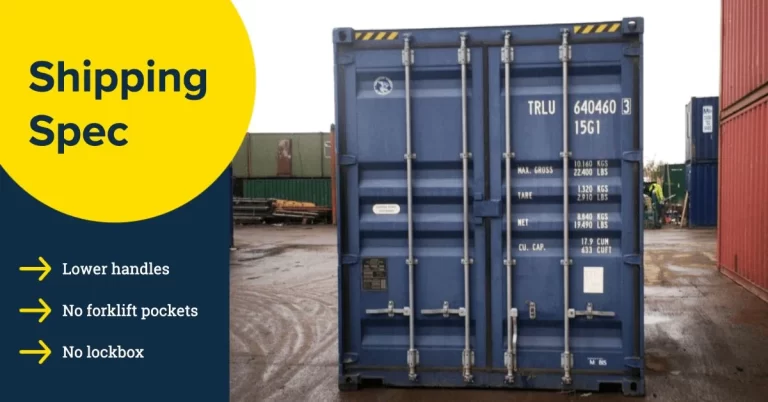
Storage Spec Containers
Storage spec containers are typically kept on the ground. Because of this, they are equipped with a lockbox for security, forklift pockets for easy maneuvering, and higher handles that can be easily opened at ground level — an advantage if used for storage or as a dwelling.
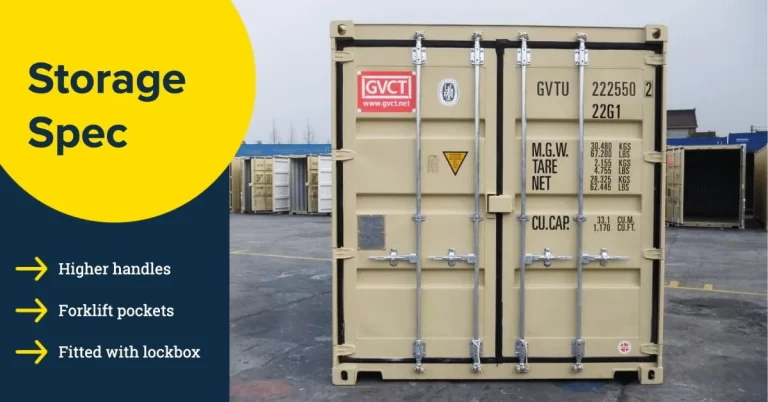
5. Container Uses
Whether you need temporary storage for family art and antiques during a home renovation or wish to construct a distinctive guest house in your backyard, different container types are well-suited for various uses. Let’s break down how to choose a shipping container for the four most popular use cases: storage, moving house, building, and shipping.
For Storage
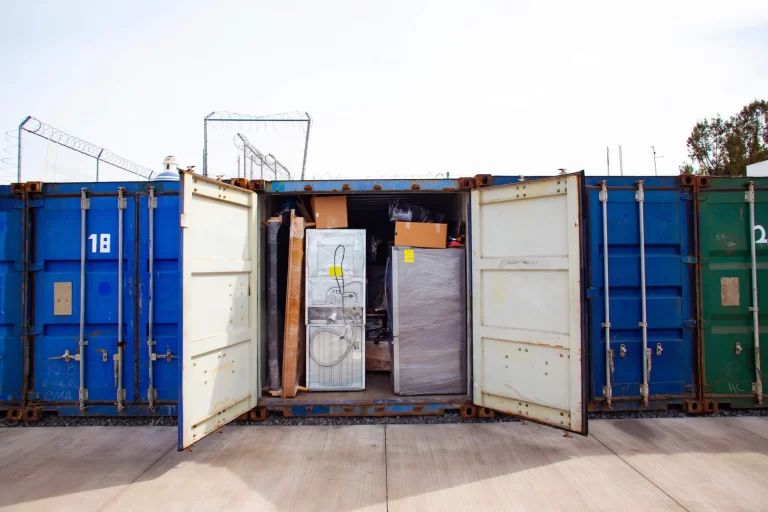
Shipping containers, whether new or used, are an excellent option for storage. They are made of COR-TEN steel, which makes them incredibly durable, and their windowless design offers maximum security and privacy. Moreover, they can be conveniently placed on your property, giving you easy access to your items whenever needed.
The two most common sizes are 20ft Shipping Containers, which have an internal volume of 1,172ft³, and 40ft shipping containers, with an internal volume of 2,385ft³.
If you plan to store the container in a location that is visible to others, it may be best to choose a new container which would have less visible wear and tear than a used one. However, both options offer the same functionality at different price points.
If your container will be placed somewhere with high levels of rainfall or snowfall, consider installing an air-conditioning unit and adding ventilation to control humidity and moisture levels inside and to prevent rust from accumulating. You can also choose to reinforce the container’s weather stripping and caulking to keep water out.
For Moving House
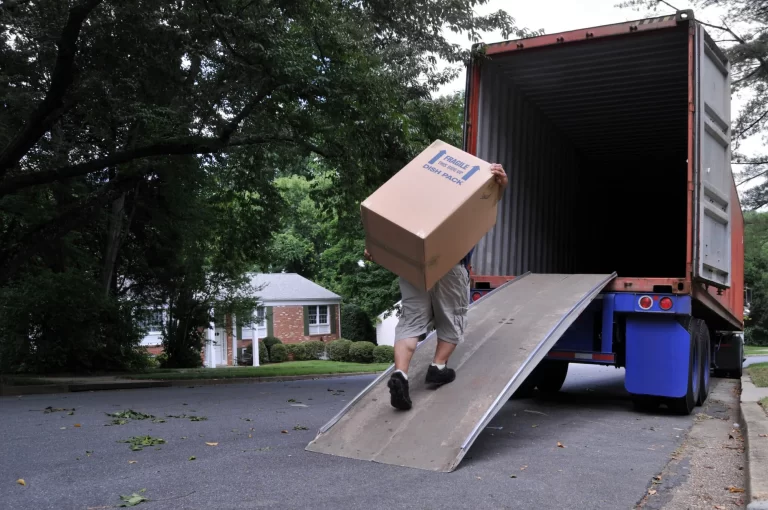
Moving to a new place can be a hassle, but a shipping container can simplify the process in many ways. Whether you are relocating to a different state or just a few blocks away, a shipping container can help you save a lot of time and keep your belongings safe and dry. It’s a versatile solution that complements or even replaces traditional moving companies. The best part is that once you are done moving, you can repurpose the shipping container for any use on your new property.
When it comes to choosing a container to move from one home to another, any condition will suffice. However, most Calebwedman customers find that a used 40ft standard (40 feet long and 8’6” tall) container works perfectly for their needs. Since the container will not be a permanent fixture on your property, opting for a used container could be a more affordable choice. It will serve its purpose well and transport your furniture and belongings safely and efficiently to your new property. For a more detailed breakdown of what to consider when buying a shipping container for moving house, check out this guide.
For Building

If you’re considering buying a shipping container and turning it into the home (or unforgettable Airbnb) of your dreams, you have an exciting journey ahead. Generally speaking, most container homes are either 20 feet or 40 feet long. But within that, you need to leave space for things like insulation — we recommend about 6 inches per side. That means, for instance, within a 20-foot container, you have 19 feet of interior room space.
If you’re building a small home, one container may be enough, but for a larger multi-level project, you’ll need multiple containers. For people with vertical designs (e.g., a loft bed area), you also need to consider height: a standard container is 8’6”, while a high-cube container is 9’6”. One issue to note is that 20-foot high-cube containers are more difficult to source than 40-foot high-cube height containers.
Regardless of the size of your project, we recommend using a new “one-trip” shipping container as the starting point for your build. These containers have only been used once to transport dry goods across the ocean and as the newest containers on the market, they have the most longevity and show virtually no signs of wear. New containers can also be stacked on top of one another. This quality makes them the best choice if your home or building project will require multiple levels of containers (think a two-story tiny home or multi-story hotel or dorm made out of containers).
To better understand how to build a shipping container home step-by-step, check out this guide (and don’t be afraid to keep it bookmarked; you’re always welcome to refer back to it).
For Shipping
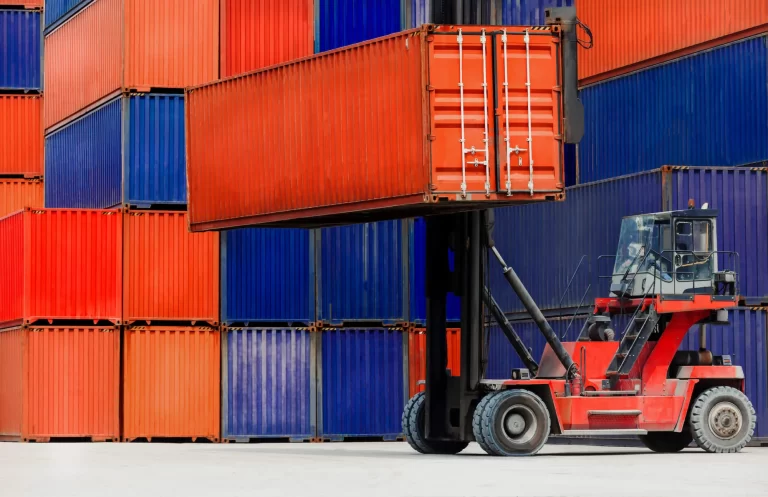
If you’re purchasing a shipping container for international shipping or exports, you have the option of choosing between a new container or a used container that meets all international shipping and export requirements and can successfully pass a CSC inspection.
What Does CSC Mean in Shipping?
In the shipping industry, CSC stands for the “Convention for Safe Containers.” This is a standard established by the International Maritime Organization (IMO) in 1972 for Shipping Container Certification. To comply with these standards, your container must have a valid CSC plate.
When deciding what container to purchase, the size and condition are two key factors to consider. If you have smaller volumes of cargo, 20-ft containers are ideal for you. However, the 40-ft container would be a better choice if you have more cargo to ship.
If you require a container that is eligible for international shipping from the purchase date, you may want to consider a new “one-trip” container. These containers come with valid CSC plates and will serve you for many years.
Alternatively, a used container could be a good option if you want to save money. Keep in mind that the certification process for a used container comes with additional costs.
Conclusion
Ultimately, choosing the right container will depend on your budget and how you plan to use your container. Whether you’re moving house, seeking storage space, or hoping to transform a container into a tiny home, farm, office, or storefront, we’re here to help you find the perfect unit. If you still have questions about choosing a shipping container, ask a Calebweman container consultant for buying support. We’re always here to assist you.
